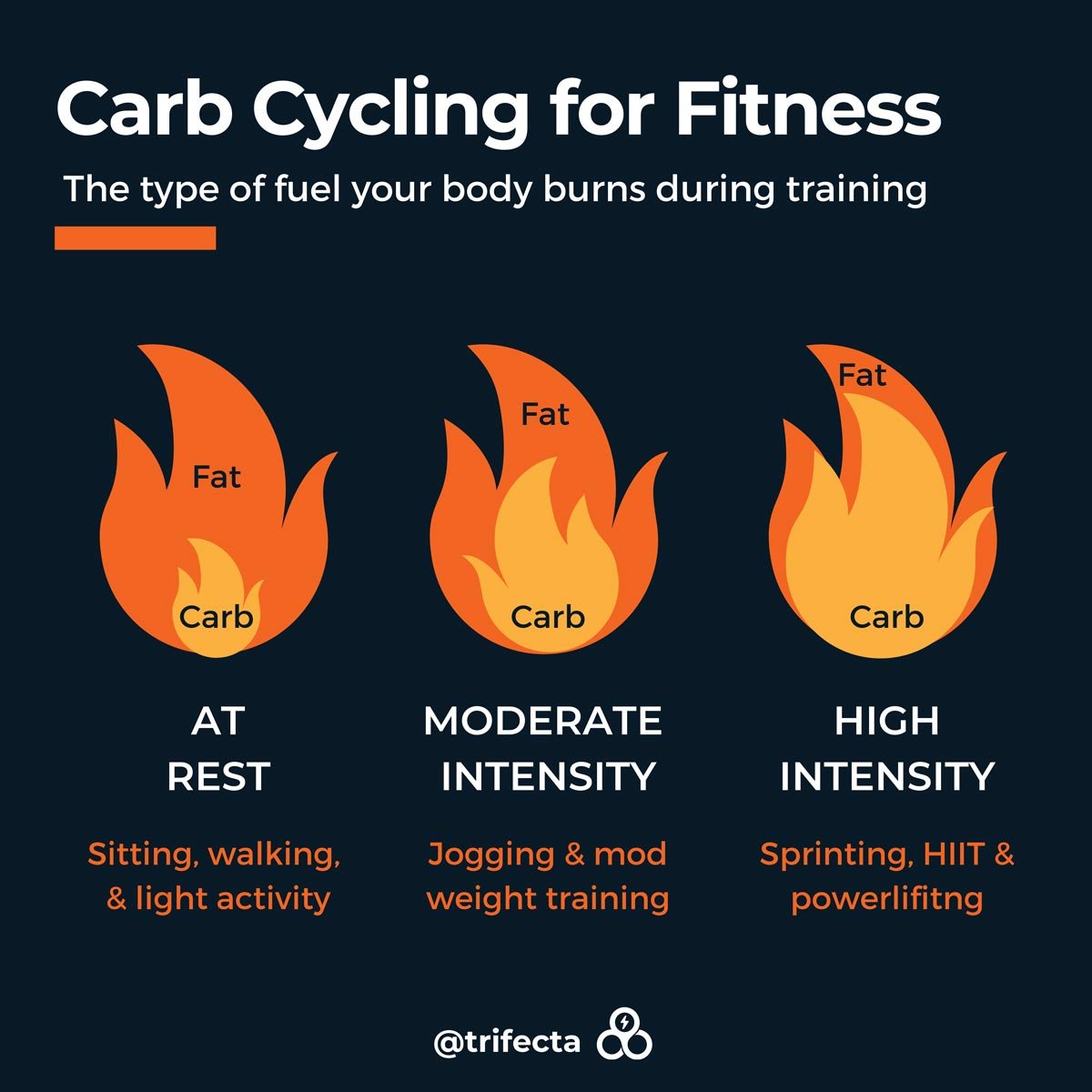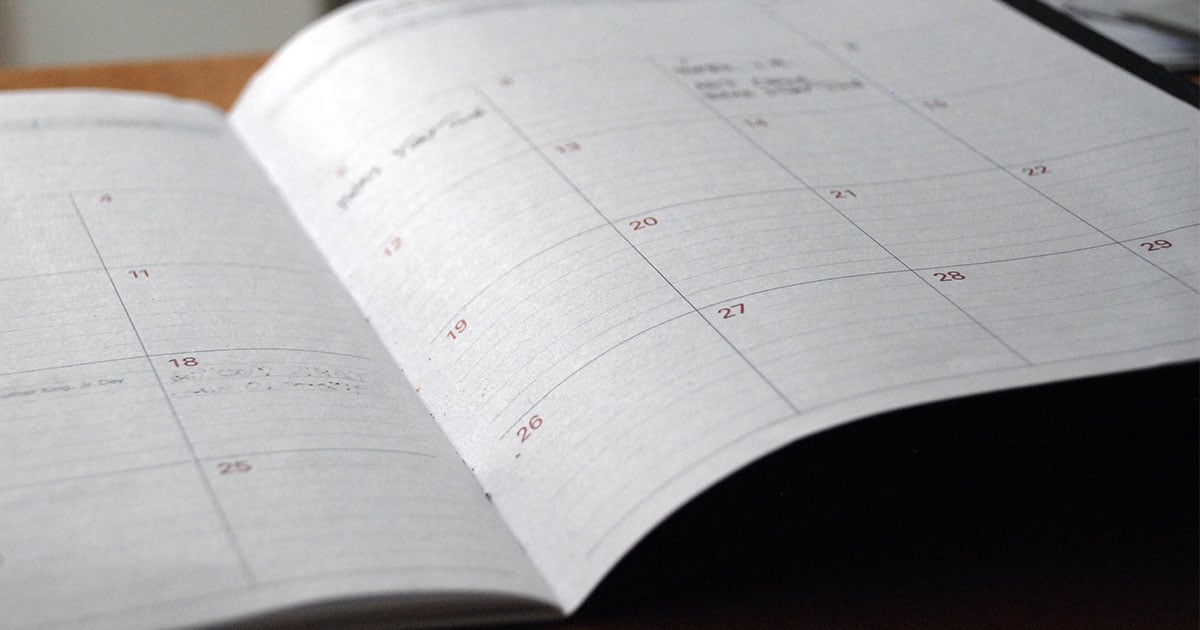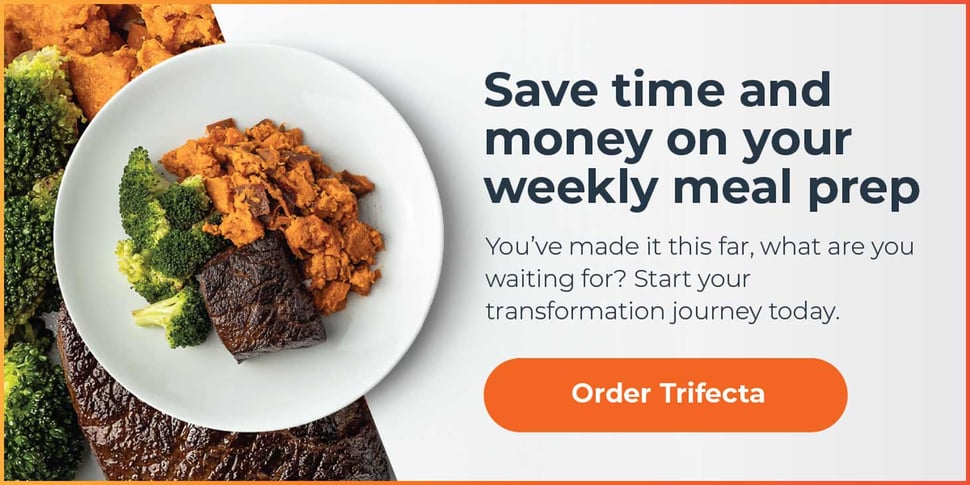How Does Carb Cycling Work?
Proper carb cycling is dictated by your daily movement - you need more carbs around the specific days and times of the day when you move more. However, sugars are not the only source of energy your body relies on, and exactly how many carbs you need to fuel your body is commonly misunderstood.
Your body also uses stored sources of energy for fuel, not just food intake. Glycogen in the liver is the storage form of carbohydrates, fatty acids are the storage form of fat, and muscle is the main storage form for protein. These bodily stores can absolutely impact your dietary intake needs.
Moreover, just because you are exercising or burning a lot of energy, doesn’t automatically mean you need more carbs in your diet. You will need to factor in the type of workouts you are doing and the intensity to fine tune your macro needs.
Here is a simple breakdown on how your body utilizes the different macronutrients for fuel based on your energy output.
Your Carbohydrate Needs at Rest (Regular Daily Movement)
At rest, when plenty of oxygen is available and you don’t need large amounts of fuel quickly, your body is using mostly fat for long-lasting energy. Since fat provides about nine calories per gram and carbs provide four calories, your body can work half as hard for the same amount of energy.
Additionally, the amount of carbohydrates you are able to store in your body for later use is limited. Most of us can only hold on to roughly 500 grams of carbohydrates at a given time, whereas our fat storage capacity is fairly unlimited.
Because carbs are a source of quick energy when you need it most, your body prefers to save these stores in case you need to kick it into high gear for survival purposes. So fat becomes the desirable fuel type when you’re at rest or at a low energy output.
The moment this changes is when you consume food and your body has immediate access to energy.
When carb cycling, these are the days or time periods when you might want to consider decreasing your carb and calorie intake.
Your Carbohydrate Needs at Moderate Output (Working Out)
During moderate exercise, your body is still using mostly fatty acids for energy but you start needing a bit more fuel more quickly. Fat metabolism is slow and requires plenty of oxygen.
As you start moving around more quickly, oxygen becomes less available and you need energy faster. Thus, it becomes harder for you to break down fatty acids and keep up, so you start using some carb stores.
If carb cycling, there is not much need to adjust your macros for moderate activity days.
Your Carbohydrate Needs at High Output (High Intensity Exercise)
When performing at higher intensity levels, oxygen is not readily available and quick energy is more needed. At this level of output your body is burning mostly sugars for fast energy, and some fat for sustained endurance.
When carb cycling, having more carbs and calories on these days, especially before and after your HIIT workouts, might help support your performance.
5 Benefits of Carb Cycling that Can Help You Lose Weight
Here are 5 benefits of carb cycling for weight loss:
- Carb cycling can make low carb diets easier
- Carb cycling might improve your ability to lose far
- Carb cycling may improve energy levels
- Carb cycling could keep your hunger in check
- Carb cycling supports your workouts

How many grams of carbs you eat each day is only one piece of the fat-burning equation, and this is far from the most important factor to consider. Regardless, fine-tuning your macro goals is not without its benefits and proper carb cycling could potentially make the process of losing weight feel a little easier.
1. Carb Cycling Can Make Low Carb Diets Easier
Sticking to a low-carb diet can feel like a serious challenge - especially when cutting carbs ultra-low, such as a ketogenic diet.
When you restrict sugars this can cause a temporary physiological response in your brain that increases cravings (especially sugar cravings), decreases willpower, and can even make you a bit cranky. This mindset can do some damage to your good intentions and make cutting calories an uphill battle.
But by feeding your body more carbohydrates when you are using them, you might be able to satisfy your cravings for them and cut back more easily on low-carb days.
Another common approach to this is “refeeding days” where individuals will restrict carbohydrates for a period of time and then designate high-carb days to replenish lost stores and give your body a break.
2. Carb Cycling Might Improve Your Ability to Lose Fat
Carb cycling won't override your need for calorie control, but it might help you process your macros more efficiently.
There is some limited research suggesting that swinging your calories and your carb intake from one day to the next may benefit your metabolism (13,14). This is likely due to improved metabolic efficiency as a result of feeding your body the right fuel at the right time.
3. Carb Cycling May Improve Energy Levels
When you aren’t getting enough gas in the tank, you’re bound to feel depleted and fatigued. This is exactly why so many people feel incredibly tired when starting a low-carb eating style - especially if they are fairly active.
4. Carb Cycling Could Keep Your Hunger in Check
Satisfying sugar cravings by giving your body carbs when it needs them is part of why carb cycling can support appetite control, but carb alteration might also positively impact hormone levels - particularly leptin.
Some limited research suggests that carb overfeeding can increase leptin levels, a key hormone involved in satiety and fat burning (15). Although much more research is needed to reveal how promising this effect might be for your weight loss goals.
5. Carb Cycling Supports Your Workouts
Carbohydrates and workouts are a match made in fitness heaven. Carbs provide the necessary energy for high-intensity training and weight lifting. Not to mention, they support muscle recovery and growth in unique ways. And getting more out of your workouts can mean more calories burned, more muscle built, and better results overall!
How to Start a Carb Cycle Diet in 5 Simple Steps
- Learn how many carbs you need a day
- Map out your week
- Adjust your daily carb goals accordingly
- Track your macros
- Assess, Adjust, and Repeat
5b2f.jpg)
While the art of carb cycling can get quite complicated depending on your diet goals and how strategic you choose to get, there are some basic principles you can start with.
Step 1: Learn How Many Carbs You Need a Day
The exact amount of each macronutrient that you need is directly dependent on your unique health and fitness needs. Thus, figuring out exactly how many grams of carbs you should be eating to support your lifestyle and body weight goals is a crucial first step.
Dial in your carb goals in just a few minutes with this simple carb calculator.
Following a ketogenic meal plan? Check out our keto carb calculator.
Step 2: Map Out Your Week
Identify when you plan to work out, when you are more active in general, and when you plan to rest. Map this out on a calendar, piece of paper, or anywhere you can easily reference as you go about your week.
Step 3: Adjust Your Daily Carb Goals Accordingly
Determine which days to keep your carbs high and which days to cut them low and note this on your weekly plan. Use the following for guidance:
- Eat fewer sugars on rest days or on days you are restricting calorie intake for weight loss.
- Eat more sugars on heavy training days, strength training days, and any time you are needing or using the extra calories.
You should also consider eating more carbs around the time of day that you are most active and less during other times of the day. Most of us are more active earlier in the day and wind down towards the evening, but this depends on the person.
When it comes to the type of sugars you are choosing, here are a few suggestions you can consider.
- Eat more simple sugars before and after a workout session for quick fuel and optimal recovery.
- Eat more starchy and high-fiber carbs throughout the day to promote fullness and better blood sugar control.
Step 4: Track Your Macros
Track your daily food and beverage intake to account for how many grams of carbs you are eating. Download a macro-friendly app to get started.
Step 5: Assess, Adjust, and Repeat
Assess your progress and adjust as needed. Pay attention to your hunger and energy levels and how your workouts are going. Then add more carbohydrates or scale back as needed.
Sample Carb Cycling Meal Plan
Here's a sample five-day carb cycling plan based on high-intensity training three days a week.

On difficult workout days, carbs are increased by 15 to 20%, fat is decreased by 10 to 25%, protein goals remain the same, and calories are slightly increased.
On rest days, carbs are decreased by 15 to 20%, fat is increased by 10 to 25%, protein goals remain the same, and calories are slightly decreased.
Your average weekly calorie and macro intake should be at or below your estimated needs for weight loss.
Should I Try Carb Cycling?
A lot more research is needed to determine how beneficial carb cycling truly is for getting lean. But the truth is, many of us live sedentary lives and don’t require high intakes of carbohydrates to thrive. In fact, most of us overdo it or choose the wrong types of carbs too often - loading up on sugary, processed foods instead of sugars from quality whole grains, fruits, and vegetables. So learning how to adjust your intake might be the game changer you need.
But you'll also want to focus on general healthy eating habits long term by including plenty of nutrient-dense foods, lean proteins, and healthy fats in addition to your carb control.
Carb cycling might be right for you if...
- You used to eat a high-carb diet and are looking to decrease your intake
- You struggle with sticking to a low-carb diet
- You are looking to get more out of your workouts
Get Your Low Carb Meal Plan Delivered
Need help dialing in your nutrition each week? Get ready to eat, macro-perfect meals delivered to your door! Our team of nutrition experts will plan, cook, and ship you a high-protein, carb-controlled meal plan of your choosing. All you need to do is heat, eat, and track your progress.

